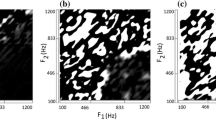Abstract
The objective of the present work was to develop automated methods for the compressed tracheal breathing sound analysis. Overnight tracheal breathing sound was recorded from ten apnoea patients. From each patient, three different types of tracheal sound deflection pattern, each of 10 min duration, were visually scored, viewing the compressed tracheal sound curve. Among them, high deflection patterns are of special interest due to the possible correlation with apnoea–hypopnoea sequences. Three methods were developed to detect patterns with high deflection, utilizing nonlinear filtering in local characterization of tracheal sounds. Method one comprises of local signal maximum, the second method of its local range, and the third of its relative range. The three methods provided 80% sensitivity with 57, 91 and 93% specificity, respectively. Method three provided an amplitude-independent approach. The nonlinear filtering based methods developed here offer effective means for analysing tracheal sounds of sleep-disordered breathing.





Similar content being viewed by others
References
Abeyratne U, Wakwella A, Hukins C (2005) Pitch jump probability measures for the analysis of snoring sounds in apnea. Physiol Meas 26:779–798
Abeyratne U, Karunajeewa A, Hukins C (2007) Mixed-phase modeling in snore sound analysis. Med Biol Eng Comput 45:791–806
American Academy of Sleep Medicine (1999) Sleep related breathing disorders in adults: recommendation for syndrome definition and measurement techniques in clinical research. Sleep 22:667–689
Brietzke S, Mair E (2007) Acoustical analysis of pediatric snoring: what can we learn. Otolaryngol Head Neck Surg 136:644–648
Caffarel J, Gibson G, Harrison J et al (2006) Comparison of manual sleep staging with automated neural network-based analysis in clinical practice. Med Biol Eng Comput 44:105–110
Cavusoglu M, Kamasak M, Erogul O et al (2007) An efficient method for snore/nonsnore classification of sleep sounds. Physiol Meas 28:841–853
Chen W, Nemoto X, Kanemitsu Y et al (2005) Unconstrained detection of respiration rhythm and pulse rate with one under-pillow sensor during sleep. Med Biol Eng Comput 43:306–312
Cummiskey J, Williams T, Krumpe P et al (1982) The detection and quantification of sleep apnea by tracheal sound recordings. Am Rev Respir Dis 126:221–224
Dalmasso F, Prota R (1996) Snoring: analysis, measurement, clinical implications and applications. Eur Respir J 9:146–159
Fiz J, Abad J, Jane R et al (1996) Acoustic analysis of snoring sound in patients with simple snoring and obstructive sleep apnoea. Eur Respir J 9:2365–2370
Gavriely N, Jensen O (1993) Theory and measurements of snores. J Appl Physiol 74:2828–2837
Hellström-Westas L, Rosen I, de Vries L et al (2006) Amplitude-integrated EEG classification and interpretation in preterm and term infants. NeoReviews 7:76–86
Himanen S-L, Huupponen E, Kulkas A et al (2007) Compressed tracheal sound analysis as a screening method for obstructive apneas and hypopneas. Sleep Med 8:S91
Huupponen E, Saastamoinen A, Joutsen A et al (2005) Anteroposterior difference in EEG sleep depth measure is reduced in apnea patients. J Med Syst 29:527–538
Issa F, Morrison D, Hadjuk E et al (1993) Digital monitoring of sleep-disordered breathing using snoring sound and arterial oxygen saturation. Am Rev Respir Dis 148:1023–1029
Kaniusas E, Pfützner H, Saletu B (2005) Acoustical signal properties for cardiac/respiratory activity and apneas. IEEE Trans Biomed Eng 52:1812–1822
Melamed S, Oksenberg A (2002) Excessive daytime sleepiness and risk of occupational injuries in non-shift daytime workers. Sleep 25:315–322
Nakano H, Hayashi M, Oshima E et al (2004) Validation of a new system of tracheal sound analysis for the diagnosis of sleep apnea–hypoapnea syndrome. Sleep 27:951–957
Ng A, Koh T, Baey E et al (2008) Could formant frequencies of snore signals be an alternative means for the diagnosis of obstructive sleep apnea? Sleep Med (in press)
Penzel T, McNames J, deChazal P (2002) Systematic comparison of different algorithms for apnoea detection based on the electrocardiogram recordings. Med Biol Eng Comput 40:402–407
Roux F, D’Ambrosio C, Mohsenin V (2000) Sleep-related breathing disorders and cardiovascular disease. Am J Med 108:396–402
Saarenpää-Heikkilä O, Lapinlampi A-M, Himanen S-L (2007) Possible connection with thin signal curve in compressed tracheal sound analysis and flow limitation pattern in children. Sleep Med 8:S91–S92
Saastamoinen A, Huupponen E, Värri A et al (2007) Systematic performance evaluation of a continuous-scale sleep depth measure. Med Eng Phys 29:1119–1131
Sovijärvi A, Helistö P, Malmberg L et al (1998) A new versatile PC-based lung sound analyzer with automatic crackle analysis (HeLSA); repeatability of spectral parameters and sound amplitude in healthy subjects. Technol Health Care 6:11–22
Van Brunt D, Lichstein K, Noe S et al (1997) Intensity pattern of snoring sounds as a predictor for sleep-disordered breathing. Sleep 20:1151–1156
Acknowledgments
This study was financially supported by the National Technology Agency of Finland, the Research fund of the Tampere University Hospital, the Jenny and Antti Wihuri foundation, the Tampere Tuberculosis foundation, the Emil Aaltonen foundation, as well as the Finnish Cultural foundation.
Author information
Authors and Affiliations
Corresponding author
Rights and permissions
About this article
Cite this article
Kulkas, A., Rauhala, E., Huupponen, E. et al. Detection of compressed tracheal sound patterns with large amplitude variation during sleep. Med Biol Eng Comput 46, 315–321 (2008). https://doi.org/10.1007/s11517-008-0317-z
Received:
Accepted:
Published:
Issue Date:
DOI: https://doi.org/10.1007/s11517-008-0317-z




